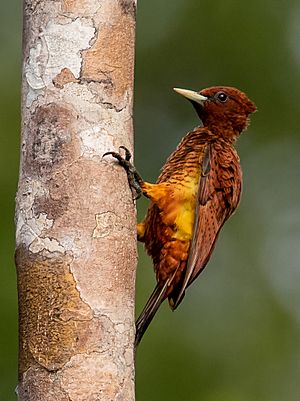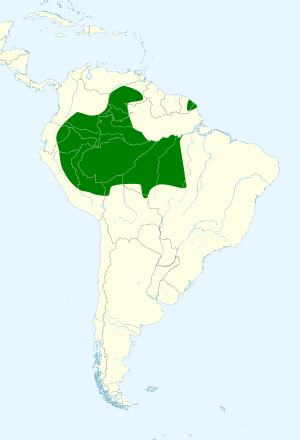Scaly-breasted woodpecker facts for kids
Quick facts for kids Scaly-breasted woodpecker |
|
|---|---|
 |
|
| Female at Manacapuru, Amazonas state, Brazil | |
| Conservation status | |
| Scientific classification | |
| Genus: |
Celeus
|
| Species: |
grammicus
|
 |
|
The scaly-breasted woodpecker (also called the scale-breasted woodpecker) is a type of bird from the woodpecker family. Its scientific name is Celeus grammicus. You can find this bird in several South American countries like Bolivia, Brazil, Colombia, Ecuador, Peru, and Venezuela.
Contents
About the Scaly-Breasted Woodpecker
The scaly-breasted woodpecker is a medium-sized bird. It is about 23 to 26 centimeters (9 to 10 inches) long. Most of these woodpeckers weigh between 63 and 75 grams (2.2 to 2.6 ounces).
What Does It Look Like?
Both male and female scaly-breasted woodpeckers have a reddish-brown head with a pointy crest. This crest often has black stripes.
- Males have a wide red patch on their face, from their beak to their ears.
- Females do not have this red patch.
The rest of their body is mostly reddish-brown. Their lower back (rump) is a pale yellowish-green or yellow. Their upper feathers have thin black stripes. Their flight feathers are dark, with reddish edges. Their tail feathers are dark brown or yellowish-brown.
Their chest is reddish-brown with black stripes. Their belly has a few black spots. The bird's beak is short and can be greenish, yellowish-green, or ivory. Their eyes are red, and their legs are dark greenish-gray.
Young Woodpeckers
Young scaly-breasted woodpeckers look a lot like the adults. However, their heads are darker. Their upper body feathers are lighter and have wider stripes.
Different Types of Scaly-Breasted Woodpeckers
There are four main types, or subspecies, of the scaly-breasted woodpecker:
- C. g. verreauxii
- C. g. grammicus (the main type)
- C. g. subcervinus
- C. g. latifasciatus
These subspecies have slight differences in their colors and markings. For example, C. g. verreauxii has lighter stripes on its underside. C. g. latifasciatus has very pale upper parts and a much paler underside.
Where Do They Live?
The scaly-breasted woodpecker lives in different parts of South America:
- C. g. verreauxii: Found in south-central Colombia and eastern Ecuador.
- C. g. grammicus: Lives in southeastern Colombia, southern Venezuela, northeastern Peru, and western Brazil.
- C. g. subcervinus: Found in Brazil, south of the Amazon River.
- C. g. latifasciatus: Lives in southeastern Peru, southwestern Brazil, and northern Bolivia.
These woodpeckers like to live in many types of forests. This includes rainforests, secondary forests (forests that have grown back), and areas with scattered trees. They usually live at elevations between 100 and 900 meters (330 to 2,950 feet) above sea level.
Woodpecker Behavior
Movement and Home
The scaly-breasted woodpecker stays in the same area all year round. It does not migrate.
What Do They Eat?
This woodpecker eats fruits, tree sap, and insects. They especially like to eat ants. They find their food on tree trunks, branches, and vines. They search for food from the very tops of trees down to the middle parts. They often look for food in small family groups. Sometimes, they join groups of different bird species that are feeding together. They get their food by pecking, poking, and picking insects off surfaces.
Reproduction and Life Cycle
The scaly-breasted woodpecker breeds between late February and April in Venezuela. They might breed later in Brazil. Not much else is known about how they raise their young.
Sounds and Calls
The most common sound the scaly-breasted woodpecker makes is like "curry-kuuu" or "fuweét-tjeeuh". The first part of the call goes up, and the second part goes down. They also make very loud, metallic "pring-pring!" sounds. Unlike some other woodpeckers, they do not drum on trees very often.
How Are They Doing?
The scaly-breasted woodpecker is considered a species of "Least Concern" by the IUCN. This means they are not currently in danger of disappearing. However, their numbers are believed to be decreasing. This is mainly because their forest homes are being cut down for farming and ranching. These woodpeckers are found in many protected areas, which helps keep them safe.
See also
 In Spanish: Carpintero rojizo para niños
In Spanish: Carpintero rojizo para niños


